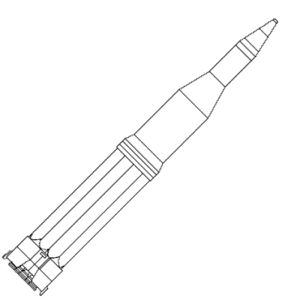
Home - Search - Browse - Alphabetic Index: 0- 1- 2- 3- 4- 5- 6- 7- 8- 9
A- B- C- D- E- F- G- H- I- J- K- L- M- N- O- P- Q- R- S- T- U- V- W- X- Y- Z
Saturn C-1
 Saturn C-1 Credit: © Mark Wade |
Status: Retired 1962. First Launch: 1961-10-27. Last Launch: 1962-11-16. Number: 3 . Payload: 9,000 kg (19,800 lb). Thrust: 5,768.00 kN (1,296,697 lbf). Gross mass: 420,000 kg (920,000 lb). Height: 49.60 m (162.70 ft). Diameter: 6.60 m (21.60 ft). Apogee: 200 km (120 mi).
LEO Payload: 9,000 kg (19,800 lb).
Family: orbital launch vehicle. People: von Braun. Country: USA. Launch Sites: Cape Canaveral, Cape Canaveral LC34. Stages: Saturn IV, Centaur C, S-I stage.
1961 October 27 - . 15:06 GMT - . Launch Site: Cape Canaveral. Launch Complex: Cape Canaveral LC34. LV Family: Saturn I. Launch Vehicle: Saturn C-1.
- Nation: USA.
Agency: NASA.
Apogee: 136 km (84 mi).
Largest known rocket launch to date, the Saturn I 1st stage booster, successful on first test flight from Atlantic Missile Range. With its eight clustered engines developing almost 1.3 million pounds of thrust at launch, the Saturn (SA-1) hurled waterfilled dummy upper stages to an altitude of 84.8 miles and 214.7 miles down range. In a postlaunch statement, Administrator Webb said: "The flight today was a splendid demonstration of the strength of our national space program and an important milestone in the buildup of our national capacity to launch heavy payloads necessary to carry out the program projected by President Kennedy on May 25.".
1962 April 25 - . 14:00 GMT - . Launch Site: Cape Canaveral. Launch Complex: Cape Canaveral LC34. LV Family: Saturn I. Launch Vehicle: Saturn C-1.
- Nation: USA.
Agency: NASA.
Apogee: 145 km (90 mi).
Second suborbital test of Saturn I. The Saturn SA-2 first stage booster was launched successfully from Cape Canaveral. The rocket was blown up intentionally and on schedule about 2.5 minutes after liftoff at an altitude of 65 miles, dumping the water ballast from the dummy second and third stages into the upper atmosphere. The experiment, Project Highwater, produced a massive ice cloud and lightning-like effects. The eight clustered H-1 engines in the first stage produced 1.3 million pounds of thrust and the maximum speed attained by the booster was 3,750 miles per hour. Modifications to decrease the slight fuel sloshing encountered near the end of the previous flight test were successful.
1962 November 16 - . 17:45 GMT - . Launch Site: Cape Canaveral. Launch Complex: Cape Canaveral LC34. LV Family: Saturn I. Launch Vehicle: Saturn C-1.
- Nation: USA.
Agency: NASA.
Apogee: 167 km (103 mi).
Third suborbital test of Saturn I. Saturn-Apollo 3 (Saturn C-1, later called Saturn I) was launched from the Atlantic Missile Range. Upper stages of the launch vehicle were filled with 23000 gallons of water to simulate the weight of live stages. At its peak altitude of 167 kilometers (104 miles), four minutes 53 seconds after launch, the rocket was detonated by explosives upon command from earth. The water was released into the ionosphere, forming a massive cloud of ice particles several miles in diameter. By this experiment, known as "Project Highwater," scientists had hoped to obtain data on atmospheric physics, but poor telemetry made the results questionable. The flight was the third straight success for the Saturn C-1 and the first with maximum fuel on board.
Back to top of page
Home - Search - Browse - Alphabetic Index: 0- 1- 2- 3- 4- 5- 6- 7- 8- 9
A- B- C- D- E- F- G- H- I- J- K- L- M- N- O- P- Q- R- S- T- U- V- W- X- Y- Z
© 1997-2019 Mark Wade - Contact
© / Conditions for Use